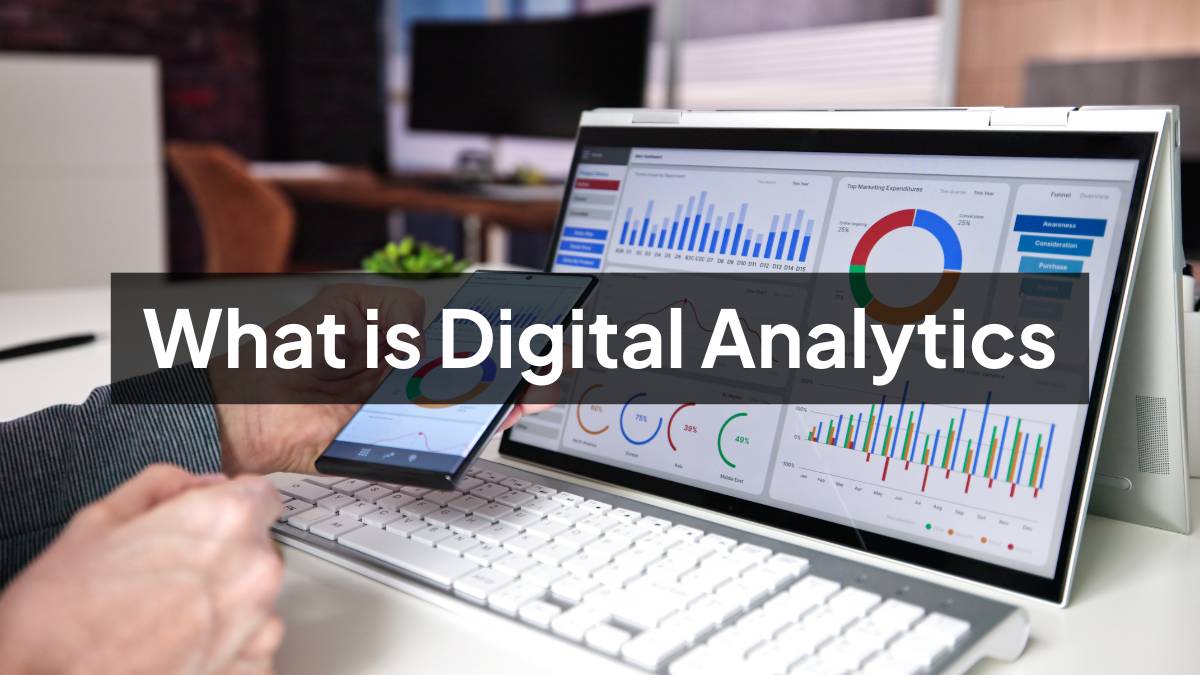What if you could see exactly what’s working – and what’s not – in your business?
Every click, scroll, and purchase online leaves behind a trail of data. But raw numbers mean nothing if you don’t know how to turn them into action. That’s where digital analytics comes in.
Digital analytics helps businesses understand how people interact with their websites, marketing campaigns, and products – so they can make smarter decisions, improve customer experiences, and drive real growth.
In this guide, we’ll break down what is digital analytics, why it matters, the different types you should know, key metrics to track, real examples of success, and how you can use it to grow your own business.
Let’s break it down.
Table of Contents
What is Digital Analytics?
Digital analytics is the process of collecting, measuring, analyzing, and interpreting data from digital sources to improve business performance.
It’s about turning numbers into insights and actions.
How it Works
- You set up tracking on your website, app, or marketing campaigns.
- Data gets collected automatically (things like page visits, clicks, form submissions, sales, etc.).
- Analytics tools organize that data into reports and dashboards.
- You analyze the data to find patterns, problems, and opportunities.
- You take action to improve based on what you learn.
Digital vs. Traditional Analytics
| Aspect | Digital Analytics | Traditional Analytics |
| Channels | Websites, apps, emails, ads | TV, radio, print |
| Data Collection | Real-time, automated | Often manual, delayed |
| Granularity | Highly detailed (user-level) | Broader, aggregated |
| Flexibility | Can pivot quickly | Slower to adapt |
Where Does Digital Analytics Data Come From?
Good question. Here’s where all that data you see in dashboards originates:
1. Website and App Data
- Page views
- Clicks
- Scroll depth
- Form submissions
2. Social Media Interactions
- Likes, shares, comments
- Follower growth
- Link clicks
3. Digital Marketing Campaigns
- PPC (Google Ads, Facebook Ads)
- SEO (organic traffic, keyword rankings)
- Display and affiliate ads
4. Email Marketing
- Open rates
- Click-through rates
- Unsubscribe rates
5. Product/E-commerce Usage Data
- Purchases
- Cart abandonments
- Product page views
6. Customer Feedback (Voice of Customer / VoC)
- Reviews
- Surveys
- NPS (Net Promoter Score)
Types of Digital Analytics
When it comes to understanding your data, not all analytics are created equal. Different types of digital analytics help you answer different questions. Let’s break them down:
1. Descriptive Analytics (What happened?)
This is the starting point. Descriptive analytics looks at what has already happened in your digital activities.
Example:
“We had 15,000 visitors on our website last month.”
It’s purely about reporting the numbers, no assumptions, no predictions. Just the facts.
2. Diagnostic Analytics (Why did it happen?)
Once you know what happened, naturally the next question is: why?
Example:
“Website traffic dropped by 20% because of a Google algorithm update.”
Diagnostic analytics digs into the causes behind your numbers. Maybe it was a bad campaign, a broken link, or even market seasonality.
3. Predictive Analytics (What will happen?)
Here’s where it gets exciting. Predictive analytics uses your past data to forecast future trends.
Example:
“Based on past trends, we expect a 20% boost in traffic during the holiday shopping season.”
It’s not a crystal ball, but it gives you a data-backed estimate of what’s coming.
4. Prescriptive Analytics (What should be done?)
This is the action-taking stage. Prescriptive analytics doesn’t just tell you what might happen, it suggests what you should do about it.
Example:
“To take advantage of the holiday season, increase your PPC ad spend by 30% and promote bundled offers.”
Each type of analytics builds on the other, helping you move from knowing, to understanding, to predicting, and finally to acting.

Enroll Now: Advanced Digital Marketing Course
Key Metrics Tracked in Digital Analytics
Think of metrics as the ingredients of your data story. If you track the right ones, you’ll get valuable insights. If you track the wrong ones, you’ll just get noise.
Here are some of the most important types of metrics to keep an eye on:
1. Traffic & Engagement Metrics
- Sessions – Total visits to your website.
- Users – How many individual people visited.
- Bounce rate – Bounce Rate is the percentage of visitors who left without interacting.
- Average time on site – How long visitors stayed on average.
These tell you how much attention you’re getting and whether your content keeps people engaged.
2. Conversion Metrics
- Click-through rate (CTR) – How many people clicked on your links or ads.
- Conversion rate – Percentage of visitors who completed a goal (signup, purchase, etc.).
- Cost per acquisition (CPA) – How much you spent to get each customer or lead.
This is where you find out if your traffic is actually turning into business.
3. Customer Journey Metrics
- Entry points (landing pages) – Where people are starting their journey on your site.
- Exit pages – Where they’re leaving.
- Funnel completion rate – How many people finish multi-step processes (like purchases).
These metrics help you fix leaks in your funnel and guide users to conversion.
4. Revenue Metrics
- Lifetime Value (LTV) – Total revenue a customer brings over their entire relationship with you.
- Return on Ad Spend (ROAS) – Revenue generated for every dollar spent on ads.
- Average order value (AOV) – How much people typically spend per purchase.
If you care about profitability (and who doesn’t?), revenue metrics are where you should be spending serious attention.
Benefits of Digital Analytics for Businesses
Alright, now let’s get to the good stuff, why it matters.
Here’s what using digital analytics can actually do for you:
1. Data-driven decision making
No more decisions based on gut feeling alone. Analytics helps you make choices backed by real numbers.
2. Optimized marketing ROI
Why waste money on ads that don’t work? Analytics tells you exactly what’s performing, and what’s not.
3. Better customer experience
When you know what your audience likes (and dislikes), you can create more personalized offers, content, and recommendations.
4. Improved product development
Data from real users helps you figure out what features or products people actually want, so you build less of what flops.
5. Higher sales & retention
Happy customers who find value in your offerings tend to stick around, and spend more. Analytics helps you fine-tune the whole experience to keep them coming back.
It’s not just about numbers, it’s about making better choices that lead to real growth.
How to Use Digital Analytics Effectively
It’s one thing to collect data, but using it properly is where the magic happens. Here’s a straightforward action plan to help you actually get value from your digital analytics setup:
1. Define Clear Goals
Before you even open an analytics dashboard, ask yourself: What am I trying to achieve here?
Do you want more leads? More online sales? Maybe it’s just more people signing up for your newsletter. Whatever it is, be specific.
Without a clear goal, analytics is just noise.
2. Select the Right Tools
Don’t overcomplicate it. Start with the essentials based on your needs.
Some popular tools:
- Google Analytics 4 (GA4): For tracking website and app performance.
- Hotjar: For visual insights like heatmaps and session recordings.
- HubSpot: Great for combining marketing, CRM, and reporting.
- Mixpanel: Ideal for product and user behavior analytics.
You don’t need to use everything, pick the tools that solve your problems right now.
3. Set Up Tracking & Tagging Properly
This is where many businesses get sloppy.
Use Google Tag Manager (GTM) to handle all your tracking codes neatly.
Make sure you’re tagging important actions on your website, like button clicks, form submissions, or product purchases.
Good tracking = better insights later.
4. Analyze & Generate Insights
Now that you’ve got the data flowing, don’t just stare at charts.
Ask:
- Why is this number going up or down?
- What’s stopping visitors from converting?
- Which pages are working, and which ones are turning people away?
Analytics should lead you to stories and patterns, not just numbers.
5. Take Data-Driven Action
This is where it all comes together.
Test new ideas based on what your data tells you:
- Change a landing page headline.
- Shift ad spend to your best-performing channel.
- Improve website speed if people are bouncing fast.
Test → Measure → Adjust → Repeat.
That’s how you turn numbers into real business growth.
Mistakes to Avoid in Digital Analytics
Even experienced marketers fall into these traps now and then. Avoiding these mistakes can save you time, money, and frustration:
1. Tracking Vanity Metrics
It’s tempting to focus on numbers that look impressive, like page views or follower counts, but if they don’t impact your goals, they don’t matter.
Focus on metrics that lead to real results: conversions, leads, sales.
2. Ignoring Qualitative Data
Numbers tell you what’s happening, but not always why.
Talk to your customers, run surveys, check reviews. Sometimes a single comment from a frustrated customer reveals more than a thousand clicks.
3. Not Setting Clear KPIs
Without clear Key Performance Indicators (KPIs) tied to your goals, your analysis will wander aimlessly.
Define: What’s the one metric that tells you whether this campaign/product/landing page is working?
4. Overcomplicating Your Tech Stack
More tools ≠ better analytics.
Start with a solid foundation (like GA4 + Hotjar or GTM) and add new tools only when you genuinely need them. Otherwise, you’ll drown in dashboards.
5. Not Acting on Insights
This one hurts the most. You collect data, find opportunities to improve, and then… nothing happens.
Data without action is wasted potential. Even small changes based on analytics can drive major results over time.
Conclusion
At the end of the day, digital analytics isn’t just about numbers – it’s about understanding your audience better and making smarter choices. Without it, you’re basically running your business with a blindfold on, hoping things work out.
With it, you can see what’s really happening – what’s working, what’s not, and where to focus next. It’s not about being perfect or having the most advanced tools; it’s about starting with what you have and improving from there.
Small, consistent actions based on data can lead to big results over time. So whether you’re running a personal blog, a startup, or a growing brand – embracing digital analytics will help you build something that actually works for your audience and for you.
FAQs on Digital Analytics
Q: What is the main purpose of digital analytics?
The main goal of digital analytics is to help businesses make smarter, data-backed decisions by understanding customer behavior across digital platforms, like websites, apps, and marketing channels.
Q: What are the best tools for digital analytics?
Some of the best tools include Google Analytics 4 (GA4) for websites, Mixpanel for product analytics, Hotjar for behavior tracking, HubSpot for marketing data, and Adobe Analytics for enterprise-level insights.
Q: How is digital analytics different from web analytics?
Web analytics tracks website-only data, while digital analytics covers all online interactions, across websites, apps, emails, paid ads, and social media, for a more complete view of your digital performance.
Q: Do small businesses need digital analytics?
Absolutely. Even small businesses benefit from tracking their digital presence. Tools like GA4 are free and can help identify opportunities to improve conversions, reach more customers, and increase sales with better targeting.
Q: How often should I analyze digital analytics data?
Ideally, review your marketing campaign data weekly to stay responsive. For broader business trends, a monthly review works well to track progress and make smarter decisions over time.
Q: What’s the most important metric in digital analytics?
It depends on your goals, but conversion rate is often key. It shows how effectively you’re turning website visitors or leads into paying customers, helping you track real business outcomes.

